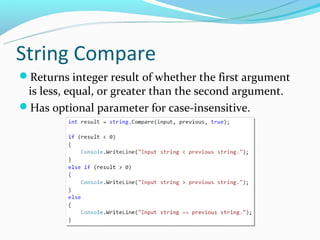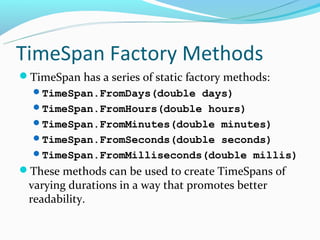Ad
Of Lambdas and LINQ
- 1. James Michael Hare 2012 Visual C# MVP Application Architect Scottrade August 3rd, 2012 http://www.BlackRabbitCoder.net Twitter: @BlkRabbitCoder
- 2. Me: Blog: http://www.BlackRabbitCoder.net Twitter: @BlkRabbitCoder Information on Scottrade Careers: http://jobs.scottrade.com Twitter: @scottradejobs
- 3. Introduction LINQ and lambdas are becoming much more prevalent in our codebases and it’s important for all of our developers to have at least a basic understanding. This presentation is designed to be a brief introduction to both lambda expressions and the more common LINQ extension methods. In addition, we will give a brief overview of the optional query syntax.
- 4. A brief history… Before we look at lambdas, let’s take a look at how delegates work in C#. A delegate is similar to a pointer to a function in C++. Delegate describe the signature of a method. Define delegates using the keyword delegate. The following delegate describes methods that have no return value and take a string parameter:
- 5. Defining matching methods Method can be static or instance. These methods match our LoggingMethod delegate:
- 6. Assigning instance methods Delegate instances can be assigned method references. If instance method assigned, provide the instance to invoke delegate from: The instance may be omitted if assigned from an instance member of the same instance.
- 7. Assigning static methods Since static methods require no instance to be invoked upon, just the class name. The class name may be omitted if the current class is the class that contains the method to be assigned.
- 8. Invoking a delegate The beauty of delegates is that they allow methods to be assigned to variables. This means you can easily change the behavior of a piece of code without needing to subclass. You invoke by calling the delegate like the method:
- 9. Anonymous methods The only problem with early .NET was that all delegate targets had to be methods. This means you’d have to create full methods for even the simplest task. The anonymous method syntax introduced in .NET 2.0 allowed writing methods on the fly at the point they would be assigned to a delegate:
- 10. Lambda expressions .NET 3.0 added lambda expression support for writing anonymous methods. Lambda expression syntax can be seen as a more concise form of the anonymous method syntax: The full lambda expression syntax is: (parameters) => { statement(s) } The lambda operator “=>” is pronounced “goes to”.
- 11. More on lambda parameters Specifying type is optional when can be inferred (string s) => { return s.Length; } (s) => { return s.Length; } If no parameters, the parenthesis are empty: () => { statement(s) } If one parameter, the parenthesis are optional: (s) => { return s.Length; } s => { return s.Length; } If several parameters, use parenthesis and commas: (x,y) => { return x > y; }
- 12. Lambda parameter naming The standard convention is a short identifier whose meaning can be inferred from context: Names are local to the lambda and can be reused if desired to represent an item flowing down a chain.
- 13. More on lambda body If body more than one statement, must separate with semicolons and enclose in braces: s => { Console.WriteLine(s); Console.Out.Flush(); } If one statement only, can omit semicolon and braces: s => { Console.Error.WriteLine(s); } s => Console.Error.WriteLine(s) If only an expression to evaluate, can omit return: s => return s.Length s => s.Length
- 14. The generic delegates Delegates can be useful for specifying pluggable behavior at runtime instead of compile time. This eliminates much of the need of inheritance in places it was used to specify different behaviors. .NET 2.0 added some common generic delegates: Predicate<T> - bool fx(T) – specifies a condition to be run against an item which returns true or false. Action<T> - void fx(T) – specifies an action to be performed on an item, no result. Action has other versions as well for varying number of parameters from 0 to 16.
- 15. More generic delegates .NET 3.5 added a new generic delegate for more general delegate specification: Func<TResult> - TResult fx() – specifies a delegate that takes no parameters and returns a TResult. Func<T, TResult> - TResult fx(T) – specifies a delegate that takes on parameter and returns a TResult. Func<T1, T2, TResult> - TResult fx(T1, T2) – specifies a delegate that takes 2 parameters and returns TResult. Func<T1…, TResult> can support up to 16 parameters. Func<T, bool> is equivalent to Predicate<T>.
- 16. Pluggable behavior Delegates allow you to create classes and algorithms with pluggable behavior without inheritance:
- 17. Pluggable behavior Behaviors can be changed on the fly:
- 18. LINQ LINQ = Language INtegrated Query. LINQ is a new query language and class libraries. LINQ class libraries can be used with or without the query syntax as desired. Most LINQ extension methods operate on sequences of data that implement IEnumerable<T>. Most LINQ extension methods specify behavior with generic delegates (Action, Func, etc). Lambda expressions are a perfect way to supply concise definitions to LINQ.
- 19. LINQ: Common behaviors Most LINQ extension methods cannot be called on a null sequence (throws ArgumentNullException). You can specify behaviors using any valid means (lambda expressions, anonymous methods, ordinary methods, or method groups). You can use the LINQ methods on any sequences that implement IEnumerable<T> including List<T>, T[], HashSet<T>, iterators, etc. Many of the LINQ methods use deferred execution (may not compute query until the data is needed).
- 20. LINQ: Chaining LINQ operations can be chained together. Each method call is independent and applies to the previous result in the chain: Where() narrows sequence to only those items whose Value property has an IsExpired property == true. Select() transforms the expired items from the Where() to return a sequence containing only the Key properties. ToList() takes the sequence of expired Keys from the Select() and returns then in a List<string>.
- 21. LINQ: Selecting and filtering Where() – Narrows sequence based on condition orders.Where(o => o.Type == OrderType.Buy) Sequence only containing orders with order type of buy. Select() – Transforms items in sequence or returns part(s) of items. orders.Select(o => o.Type) Sequence only containing the types of the orders. These two are sometimes confused, remember not to use Select to try to filter or you get a sequence of bool. orders.Select(o => o.Type == OrderType.Buy)
- 22. LINQ: Consistency checks All() – True if all items satisfy a predicate: requests.All(r => r.IsValid) True if IsValid returns true for all items. employees.All(e => e.Ssn != null) True if Ssn is not null for all items. Any() – True if at least one satisfies predicate: requests.Any(r => !r.IsValid) True if any item returns IsValid of false. results.Addresses.Any() True if Addresses contains at least one item.
- 23. LINQ: Membership and count Contains() – True if sequence contains item. orderTypes.Contains(“Buy”) True if contains string “buy” based on default string comparer. orderTypes.Contains(“buy”, comparer) True if contains “buy” based on given string comparer. Count() – Number of items (or matches) in sequence. requests.Count(r => !r.IsValid) Count of items where IsValid returns false requests.Count() Count of all items in sequence
- 24. LINQ: Combine and reduce Distinct() – Sequence without duplicates. orderIds.Distinct() A list of all unique order ids based on default comparer. Concat() – Concatenates sequences. defaultValues.Concat(otherValues) Sequence containing defaultValues followed by otherValues. Union() – Concatenates without duplicates. defaultValues.Union(otherValues) Sequence with items from defaultValues followed by items from otherValues without any duplicates.
- 25. LINQ: First item or match First() – Returns first item or match, throws if none. orders.First() Returns first order, throws if none. orders.First(o => o.Type == OrderType.Buy) Returns first buy order, throws if no buy orders. FirstOrDefault() – Returns first item, default if none. orders.FirstOrDefault() Returns first order, default if no orders. Default based on type (null for reference, 0 for numeric, etc) orders.FirstOrDefault(o => o.Id > 100) Returns first order with id > 100, or default if no match.
- 26. LINQ: Other items and matches Last() / LastOrDefault() Similar to First except returns last match or item in list. Default version returns default of type if no match. ElementAt() / ElementAtOrDefault() Returns element at the given position (zero-indexed). Default version returns default of type if position > count. Single() / SingleOrDefault() Very similar to First except ensures that only one item exists that matches.
- 27. LINQ: Set operations Except() – Set difference, subtracts sequences snackFoods.Except(healthyFoods) Returns first sequence minus elements in the second. Sequence of snack foods that are not healthy foods. Intersect() – Set intersection, common sequence snackFoods.Intersect(healthyFoods) Returns first sequence minus elements in the second. Sequence of foods that are snack foods and healthy foods. Union() – Combines sequences without duplicates. snackFoods.Union(healthyFoods) Returns both sequences combined with duplicates removed.
- 28. LINQ: Aggregation operations Sum() – Adds all in from a sequence orders.Sum(o => o.Quantity) Average() – Agerage of all items in a sequence orders.Average(o => o.Quantity) Min()– Finds minimum item in sequence orders.Min(o => o.Quantity) Max() – Finds maximum item in sequence orders.Max(o => o.Quantity) Aggregate() – Performs custom aggregation orders.Aggregate(0.0, (total, o) => total += o.Quantity * o.Price)
- 29. LINQ: Grouping GroupBy() – Groups a sequence by criteria orders.GroupBy(o => o.Type) Organizes the sequence into groups of sequences. In this case, organizes orders into sequences by order type. Each element in resulting sequence is grouping with Key being the group criteria and the grouping being a sequence:
- 30. LINQ: Ordering OrderBy() – Orders in ascending order orders.OrderBy(o => o.Id) Orders in ascending order by order id. OrderByDescending() – Orders in descending order Orders.OrderByDescending(o => o.Id) Orders in descending order by order id. ThenBy() – Adds additional ascending criteria Orders.OrderBy(o => o.Id).ThenBy(o => o.Type) Orders in ascending order by id and when ids are same ordered by order type as a secondary ordering. ThenByDescending() – As above, but descending.
- 31. LINQ: Exporting to Collection ToArray() – Returns sequence as an array. orders.OrderBy(o => o.Id).ToArray() Retrieves orders ordered by id into an array. ToList() – Returns sequence as a List Orders.OrderBy(o => o.Id).ToList() Retrieves orders ordered by id into a List<Order>. ToDictionary() – Returns sequence as Dictionary Orders.ToDictionary(o => o.Id) Retrieves orders in a dictionary where the Id is the key. ToLookup() – Returns sequence of IGrouping Orders.ToLookup(o => o.Type) Retrieves orders into groups of orders keyed by order type.
- 32. Query Syntax The query syntax is an alternative way to write LINQ expressions. Microsoft tends to recommend the query syntax as it tends to be easier to read. Ultimately, it is reduced to the same method calls we’ve already seen, so can use either. There are some methods which are not directly callable using the query syntax.
- 33. Query Syntax All queries start with the from clause in the form: from o in orders Declares variable representing current and source sequence. Similar to foreach(var o in orders) except deferred. All queries must end with a select or group clause: from o in orders select o.Id Projects output same as the Select() extension method. from o in orders group o by o.Id Groups output same as the GroupBy() extension method.
- 34. Query Syntax In between the from and the select/group clauses, you can filter, order, and join as desired: where – filters to only matching objects, like Where(). into – allows storage of results from a groupby, join, or select for use in later clauses. order – sorts the results, can use ascending or descending modifiers, like the OrderBy() method family. join – joins two sequences together, like Join(). let – allows storage of result from sub-expression for use in later clauses.
- 35. Same Query, Different Syntax These two queries are the same, just different syntax:
- 36. Pros and cons Pros: Lambda expressions are much more concise than full methods for simple tasks. LINQ expressions simplifies implementation by using .NET libraries that are optimized and fully tested. Once you learn the lambdas and LINQ, ultimately the code is much more readable and easier to maintain. Cons: The lambda syntax and LINQ methods take some getting used to at first (short ramp-up time).
- 37. Summary Delegates help create more modular code without the need for inheritance. Lambdas are just an easy way to assign an anonymous method to a delegate. LINQ introduces a great class library for performing common operations on sequences of data. Using lambdas and LINQ can help reduce code size and improve code readability and maintainability. Care should be taken to make lambda expressions concise and meaningful while still readable.
- 38. Questions?








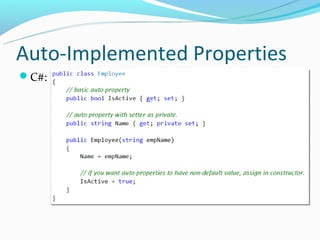


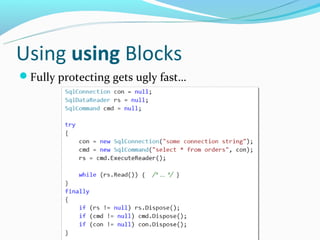




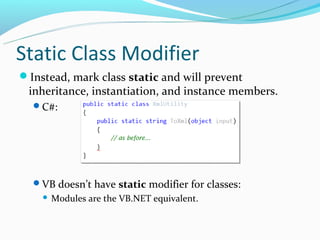

![LINQ: Common behaviors
Most LINQ extension methods cannot be called on a
null sequence (throws ArgumentNullException).
You can specify behaviors using any valid means
(lambda expressions, anonymous methods, ordinary
methods, or method groups).
You can use the LINQ methods on any sequences
that implement IEnumerable<T> including List<T>,
T[], HashSet<T>, iterators, etc.
Many of the LINQ methods use deferred execution
(may not compute query until the data is needed).](https://image.slidesharecdn.com/oflambdasandlinq-110517121058-phpapp01/85/Of-Lambdas-and-LINQ-19-320.jpg)


